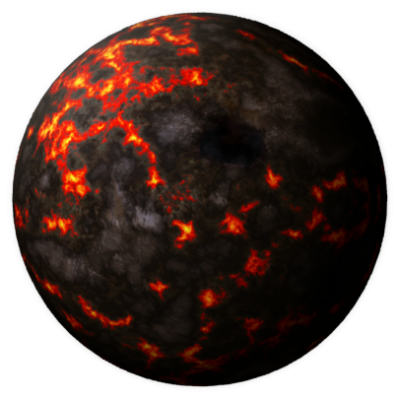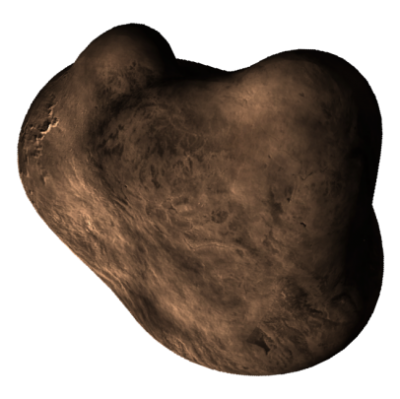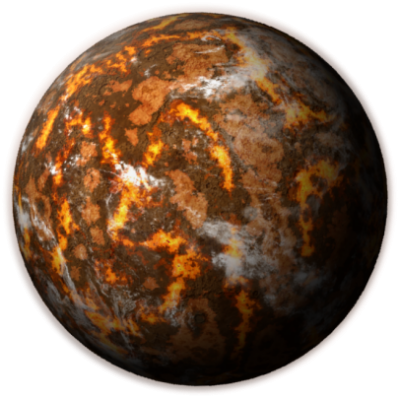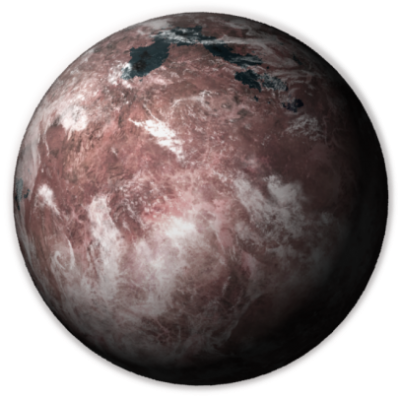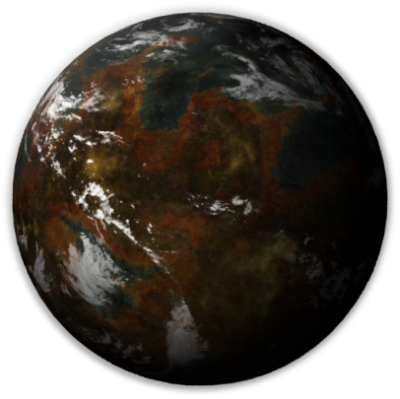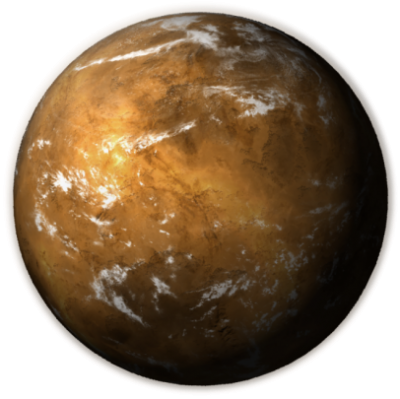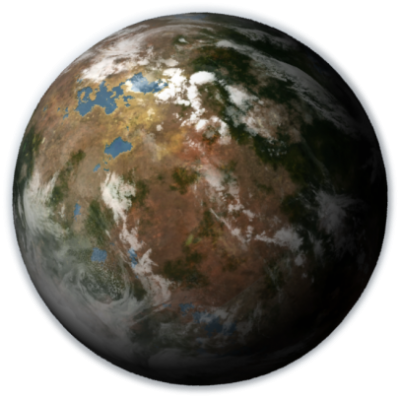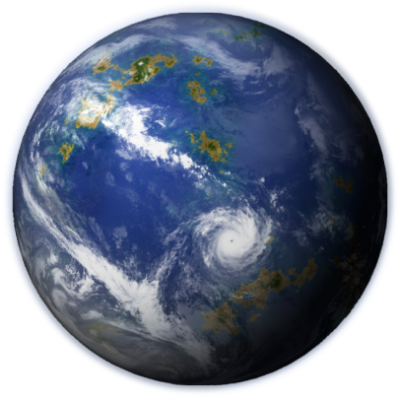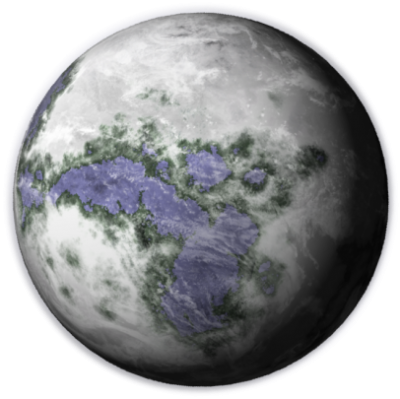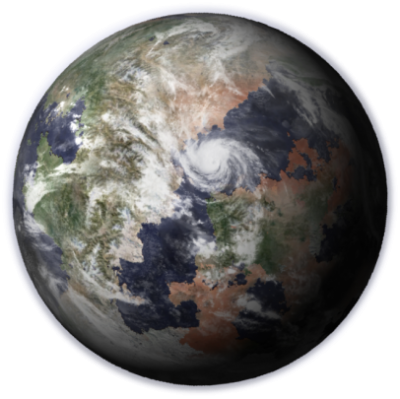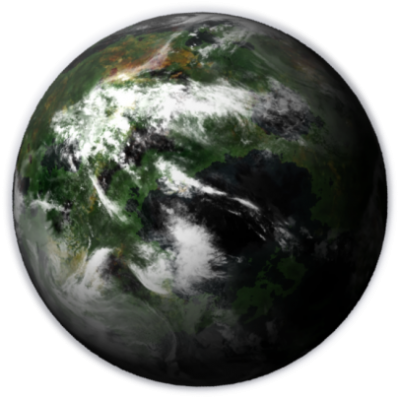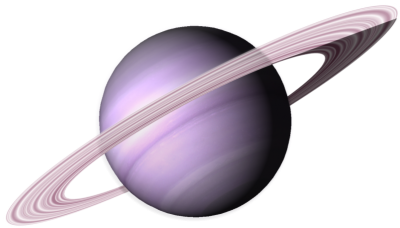Planetary Classification: Difference between revisions
From Star Trek: Theurgy Wiki
Auctor Lucan (talk | contribs) No edit summary |
Jreeves1701 (talk | contribs) |
||
| (7 intermediate revisions by 2 users not shown) | |||
| Line 38: | Line 38: | ||
== Class A - Geothermal == | == Class A - Geothermal == | ||
'''Class A''' planets are very small, barren | '''Class A''' planets are very small, barren worlds rife with volcanic activity. This activity traps carbon dioxide in the atmosphere and keeps temperatures on Class A planets very hot, no matter the location in a star system. When the volcanic activity ceases, the planet "dies" and is then considered a Class C planet. | ||
worlds rife with volcanic activity. This | |||
activity traps carbon dioxide in the | |||
atmosphere and keeps temperatures | |||
on Class A planets very hot, no matter | |||
the location in a star system. When | |||
the volcanic activity ceases, the | |||
planet "dies" and is then considered a | |||
Class C planet. | |||
{| class="wikitable" width="674px" style="background: #252525; color: white;" | {| class="wikitable" width="674px" style="background: #252525; color: white;" | ||
|style="width:100px"|AGE||0-2 billion years||rowspan="8" style="width:100px; background-color:#000000;"|[[file:ClassA3.png]] | |style="width:100px"|AGE||0-2 billion years||rowspan="8" style="width:100px; background-color:#000000;"|[[file:ClassA3.png|400x400px]] | ||
|- | |- | ||
|DIAMETER||1,000 - 10,000 km | |DIAMETER||1,000 - 10,000 km | ||
| Line 67: | Line 59: | ||
== Class B - Geomorteus == | == Class B - Geomorteus == | ||
'''Class B''' planets are generally small | '''Class B''' planets are generally small worlds located within a star system's Hot Zone. Highly unsuited for humanoid life, Class B planets have thin atmospheres composed primarily of helium and sodium. The surface is molten and highly unstable; temperatures range from 450° in the daylight, to nearly -200° at night. No life forms have ever been observed on Class B planetoids. | ||
worlds located within a star system's | |||
Hot Zone. Highly unsuited for | |||
humanoid life, Class B planets have | |||
thin atmospheres composed primarily | |||
of helium and sodium. The surface is | |||
molten and highly unstable; | |||
temperatures range from 450° in the | |||
daylight, to nearly -200° at night. No | |||
life forms have ever been observed on | |||
Class B planetoids. | |||
{| class="wikitable" width="674px" style="background: #252525; color: white;" | {| class="wikitable" width="674px" style="background: #252525; color: white;" | ||
|style="width:100px"|AGE||0-10 billion years||rowspan="8" style="width:100px; background-color:#000000;"|[[file:ClassB3.png]] | |style="width:100px"|AGE||0-10 billion years||rowspan="8" style="width:100px; background-color:#000000;"|[[file:ClassB3.png|400x400px]] | ||
|- | |- | ||
|DIAMETER||1,000 - 10,000 km | |DIAMETER||1,000 - 10,000 km | ||
| Line 101: | Line 83: | ||
{| class="wikitable" width="674px" style="background: #252525; color: white;" | {| class="wikitable" width="674px" style="background: #252525; color: white;" | ||
|style="width:100px"|AGE||2-10 billion years||rowspan="8" style="width:100px; background-color:#000000;"|[[file:ClassC3.png]] | |style="width:100px"|AGE||2-10 billion years||rowspan="8" style="width:100px; background-color:#000000;"|[[file:ClassC3.png|400x400px]] | ||
|- | |- | ||
|DIAMETER||1,000 - 10,000 km | |DIAMETER||1,000 - 10,000 km | ||
| Line 119: | Line 101: | ||
== Class D - Dwarf == | == Class D - Dwarf == | ||
Also known as Plutonian objects, | Also known as Plutonian objects, these tiny worlds are composed primarily of ice and are generally not considered true planets. Many moons and asteroids are considered '''Class D''', as are the larger objects in a star system's Kuiper Belt. Most are not suitable for humanoid life, though many can be colonized via pressure domes. | ||
these tiny worlds are composed | |||
primarily of ice and are generally not | |||
considered true planets. Many moons | |||
and asteroids are considered '''Class D''', | |||
as are the larger objects in a star | |||
system's Kuiper Belt. Most are not | |||
suitable for humanoid life, though | |||
many can be colonized via pressure | |||
domes. | |||
{| class="wikitable" width="674px" style="background: #252525; color: white;" | {| class="wikitable" width="674px" style="background: #252525; color: white;" | ||
|style="width:100px"|AGE||2-10 billion years||rowspan="8" style="width:100px; background-color:#000000;"|[[file:ClassD3.png]] | |style="width:100px"|AGE||2-10 billion years||rowspan="8" style="width:100px; background-color:#000000;"|[[file:ClassD3.png|400x400px]] | ||
|- | |- | ||
|DIAMETER||100 - 4,000 km | |DIAMETER||100 - 4,000 km | ||
| Line 149: | Line 122: | ||
== Class E - Geoplastic == | == Class E - Geoplastic == | ||
'''Class E''' planets represent the earliest | '''Class E''' planets represent the earliest stage in the evolution of a habitable planet. The core and crust is completely molten, making the planets susceptible to solar winds and radiation and subject to extremely high surface temperatures. The atmosphere is very thin, composed of hydrogen and helium. As the surface cools, the core and crust begin to harden, and the planet evolves into a Class F world. | ||
stage in the evolution of a habitable | |||
planet. The core and crust is | |||
completely molten, making the planets | |||
susceptible to solar winds and | |||
radiation and subject to extremely | |||
high surface temperatures. The | |||
atmosphere is very thin, composed of | |||
hydrogen and helium. As the surface | |||
cools, the core and crust begin to | |||
harden, and the planet evolves into a | |||
Class F world. | |||
{| class="wikitable" width="674px" style="background: #252525; color: white;" | {| class="wikitable" width="674px" style="background: #252525; color: white;" | ||
|style="width:100px"|AGE||2-10 billion years||rowspan="8" style="width:100px; background-color:#000000;"|[[file:ClassE3.png]] | |style="width:100px"|AGE||2-10 billion years||rowspan="8" style="width:100px; background-color:#000000;"|[[file:ClassE3.png|400x400px]] | ||
|- | |- | ||
|DIAMETER||10,000 - 15,000 km | |DIAMETER||10,000 - 15,000 km | ||
| Line 181: | Line 143: | ||
== Class F - Geometallic == | == Class F - Geometallic == | ||
A Class E planet makes the transition | A Class E planet makes the transition to '''Class F''' once the crust and core have begun to harden. Volcanic activity is also commonplace on Class F worlds; the steam expelled from volcanic eruptions eventually condenses into water, giving rise to shallow seas in which simple bacteria thrive. When the planet's core is sufficiently cool, the volcanic activity ceases and the planet is considered Class G. | ||
to '''Class F''' once the crust and core | |||
have begun to harden. Volcanic | |||
activity is also commonplace on Class F | |||
worlds; the steam expelled from | |||
volcanic eruptions eventually | |||
condenses into water, giving rise to | |||
shallow seas in which simple bacteria | |||
thrive. When the planet's core is | |||
sufficiently cool, the volcanic activity | |||
ceases and the planet is considered | |||
Class G. | |||
{| class="wikitable" width="674px" style="background: #252525; color: white;" | {| class="wikitable" width="674px" style="background: #252525; color: white;" | ||
|style="width:100px"|AGE||1-3 billion years||rowspan="8" style="width:100px; background-color:#000000;"|[[file:ClassF3.png]] | |style="width:100px"|AGE||1-3 billion years||rowspan="8" style="width:100px; background-color:#000000;"|[[file:ClassF3.png|400x400px]] | ||
|- | |- | ||
|DIAMETER||10,000 - 15,000 km | |DIAMETER||10,000 - 15,000 km | ||
| Line 213: | Line 164: | ||
== Class G - Geocrystalline == | == Class G - Geocrystalline == | ||
After the core of a Class F planet is | After the core of a Class F planet is sufficiently cool, volcanic activity lessens and the planet is considered '''Class G'''. Oxygen and nitrogen are present in some abundance in the atmosphere, giving rise to increasingly complex organisms such as primitive vegetation like algae, and animals similar to sponges and jellyfish. As the surface cools, a Class G planet can evolve into a Class H, K, L, M, N, O, or P class world. | ||
sufficiently cool, volcanic activity | |||
lessens and the planet is considered | |||
'''Class G'''. Oxygen and nitrogen are | |||
present in some abundance in the | |||
atmosphere, giving rise to increasingly | |||
complex organisms such as primitive | |||
vegetation like algae, and animals | |||
similar to sponges and jellyfish. As the | |||
surface cools, a Class G planet can | |||
evolve into a Class H, K, L, M, N, O, or | |||
P class world. | |||
{| class="wikitable" width="674px" style="background: #252525; color: white;" | {| class="wikitable" width="674px" style="background: #252525; color: white;" | ||
|style="width:100px"|AGE||3-4 billion years||rowspan="8" style="width:100px; background-color:#000000;"|[[file:ClassG3.png]] | |style="width:100px"|AGE||3-4 billion years||rowspan="8" style="width:100px; background-color:#000000;"|[[file:ClassG3.png|400x400px]] | ||
|- | |- | ||
|DIAMETER||10,000 - 15,000 km | |DIAMETER||10,000 - 15,000 km | ||
| Line 245: | Line 185: | ||
== Class H - Desert == | == Class H - Desert == | ||
A planet is considered '''Class H''' if less | A planet is considered '''Class H''' if less than 20% of its surface is water. Though many Class H worlds are covered in sand, it is not required to be considered a desert; it must, however, receive little in the way of precipitation. Drought-resistant plants and animals are common on Class H worlds, and many are inhabited by humanoid populations. Most Class H worlds are hot and arid, but conditions can vary greatly. | ||
than 20% of its surface is water. | |||
Though many Class H worlds are | |||
covered in sand, it is not required to | |||
be considered a desert; it must, | |||
however, receive little in the way of | |||
precipitation. Drought-resistant | |||
plants and animals are common on | |||
Class H worlds, and many are | |||
inhabited by humanoid populations. | |||
Most Class H worlds are hot and arid, | |||
but conditions can vary greatly. | |||
{| class="wikitable" width="674px" style="background: #252525; color: white;" | {| class="wikitable" width="674px" style="background: #252525; color: white;" | ||
|style="width:100px"|AGE||4-10 billion years||rowspan="8" style="width:100px; background-color:#000000;"|[[file:ClassH3.png]] | |style="width:100px"|AGE||4-10 billion years||rowspan="8" style="width:100px; background-color:#000000;"|[[file:ClassH3.png|400x400px]] | ||
|- | |- | ||
|DIAMETER||8,000 - 15,000 km | |DIAMETER||8,000 - 15,000 km | ||
| Line 277: | Line 206: | ||
== Class I - Ice Giant (Uranian) == | == Class I - Ice Giant (Uranian) == | ||
Also known as Uranian planets, these | Also known as Uranian planets, these gaseous giants have vastly different compositions from other giant worlds; the core is mostly rock and ice surrounded by a tenuous layers of methane, water, and ammonia. Additionally, the magnetic field is sharply inclined to the axis of rotation. '''Class I''' planets typically form on the fringe of a star system. | ||
gaseous giants have vastly different | |||
compositions from other giant worlds; | |||
the core is mostly rock and ice | |||
surrounded by a tenuous layers of | |||
methane, water, and ammonia. | |||
Additionally, the magnetic field is | |||
sharply inclined to the axis of | |||
rotation. '''Class I''' planets typically form | |||
on the fringe of a star system. | |||
{| class="wikitable" width="674px" style="background: #252525; color: white;" | {| class="wikitable" width="674px" style="background: #252525; color: white;" | ||
|style="width:100px"|AGE||2-10 billion years||rowspan="8" style="width:100px; background-color:#000000;"|[[file:ClassI3.png]] | |style="width:100px"|AGE||2-10 billion years||rowspan="8" style="width:100px; background-color:#000000;"|[[file:ClassI3.png|400x400px]] | ||
|- | |- | ||
|DIAMETER||30,000 - 100,000 km | |DIAMETER||30,000 - 100,000 km | ||
| Line 307: | Line 227: | ||
== Class J - Gas Giant (Jovian) == | == Class J - Gas Giant (Jovian) == | ||
'''Class J''' planets are massive spheres of | '''Class J''' planets are massive spheres of liquid and gaseous hydrogen, with small cores of metallic hydrogen. Their atmospheres are extremely turbulent, with wind speeds in the most severe storms reaching 600 kph. Many Class J planets also possess impressive ring systems, composed primarily of rock, dust, and ice. They form in the Cold Zone of a star system, though typically much closer than Class I planets. | ||
liquid and gaseous hydrogen, with | |||
small cores of metallic hydrogen. | |||
Their atmospheres are extremely | |||
turbulent, with wind speeds in the | |||
most severe storms reaching 600 kph. | |||
Many Class J planets also possess | |||
impressive ring systems, composed | |||
primarily of rock, dust, and ice. They | |||
form in the Cold Zone of a star | |||
system, though typically much closer | |||
than Class I planets. | |||
{| class="wikitable" width="674px" style="background: #252525; color: white;" | {| class="wikitable" width="674px" style="background: #252525; color: white;" | ||
|style="width:100px"|AGE||2-10 billion years||rowspan="8" style="width:100px; background-color:#000000;"|[[file:ClassJ3.png]] | |style="width:100px"|AGE||2-10 billion years||rowspan="8" style="width:100px; background-color:#000000;"|[[file:ClassJ3.png|400x400px]] | ||
|- | |- | ||
|DIAMETER||50,000 - 500,000 km | |DIAMETER||50,000 - 500,000 km | ||
| Line 339: | Line 248: | ||
== Class K - Adaptable == | == Class K - Adaptable == | ||
Though similar in appearance to Class | Though similar in appearance to Class H worlds, '''Class K''' planets lack the robust atmosphere of their desert counterparts. Though rare, primitive single-celled organisms have been known to exist, though more complex life never evolves. Humanoid colonization is, however, possible through the use of pressure domes and in some cases, terraforming. | ||
H worlds, '''Class K''' planets lack the | |||
robust atmosphere of their desert | |||
counterparts. Though rare, primitive | |||
single-celled organisms have been | |||
known to exist, though more complex | |||
life never evolves. Humanoid | |||
colonization is, however, possible | |||
through the use of pressure domes | |||
and in some cases, terraforming. | |||
{| class="wikitable" width="674px" style="background: #252525; color: white;" | {| class="wikitable" width="674px" style="background: #252525; color: white;" | ||
|style="width:100px"|AGE||4-10 billion years||rowspan="8" style="width:100px; background-color:#000000;"|[[file:ClassK3.png]] | |style="width:100px"|AGE||4-10 billion years||rowspan="8" style="width:100px; background-color:#000000;"|[[file:ClassK3.png|400x400px]] | ||
|- | |- | ||
|DIAMETER||5,000 - 10,000 km | |DIAMETER||5,000 - 10,000 km | ||
| Line 369: | Line 269: | ||
== Class L - Marginal == | == Class L - Marginal == | ||
'''Class L''' planets are typically rocky, | '''Class L''' planets are typically rocky, forested worlds devoid of animal life. They are, however, well-suited for humanoid colonization and are prime candidates for terraforming. Water is typically scarce, and if less than 20% of the surface is covered in water, the planet is considered Class H. | ||
forested worlds devoid of animal life. | |||
They are, however, well-suited for | |||
humanoid colonization and are prime | |||
candidates for terraforming. Water is | |||
typically scarce, and if less than 20% | |||
of the surface is covered in water, | |||
the planet is considered Class H. | |||
{| class="wikitable" width="674px" style="background: #252525; color: white;" | {| class="wikitable" width="674px" style="background: #252525; color: white;" | ||
|style="width:100px"|AGE||4-10 billion years||rowspan="8" style="width:100px; background-color:#000000;"|[[file:ClassL3.png]] | |style="width:100px"|AGE||4-10 billion years||rowspan="8" style="width:100px; background-color:#000000;"|[[file:ClassL3.png|400x400px]] | ||
|- | |- | ||
|DIAMETER||10,000 - 15,000 km | |DIAMETER||10,000 - 15,000 km | ||
| Line 397: | Line 290: | ||
== Class M - Terrestrial == | == Class M - Terrestrial == | ||
'''Class M''' planets are robust and varied | '''Class M''' planets are robust and varied worlds composed primarily of silicate rocks, and are highly suited for humanoid life. To be considered Class M, between 20% and 80% of the surface must be covered in water; it must have a breathable oxygen-nitrogen atmosphere and temperate climate. | ||
worlds composed primarily of silicate | |||
rocks, and are highly suited for | |||
humanoid life. To be considered Class | |||
M, between 20% and 80% of the | |||
surface must be covered in water; it | |||
must have a breathable oxygen- | |||
nitrogen atmosphere and temperate | |||
climate. | |||
{| class="wikitable" width="674px" style="background: #252525; color: white;" | {| class="wikitable" width="674px" style="background: #252525; color: white;" | ||
|style="width:100px"|AGE||4-10 billion years||rowspan="8" style="width:100px; background-color:#000000;"|[[file:ClassM3.png]] | |style="width:100px"|AGE||4-10 billion years||rowspan="8" style="width:100px; background-color:#000000;"|[[file:ClassM3.png|400x400px]] | ||
|- | |- | ||
|DIAMETER||10,000 - 15,000 km | |DIAMETER||10,000 - 15,000 km | ||
| Line 426: | Line 311: | ||
== Class N - Reducing == | == Class N - Reducing == | ||
Though frequently found in the | Though frequently found in the Ecosphere, '''Class N''' planets are not conducive to life. The terrain is barren, with surface temperatures in excess of 500° and an atmospheric pressure more than 90 times that of a Class-M world. Additionally, the atmosphere is very dense and composed of carbon dioxide; water exists only in the form of thick,vaporous clouds that shroud most of the planet. | ||
Ecosphere, '''Class N''' planets are not | |||
conducive to life. The terrain is | |||
barren, with surface temperatures in | |||
excess of 500° and an atmospheric | |||
pressure more than 90 times that | |||
of a Class-M world. Additionally, the | |||
atmosphere is very dense and | |||
composed of carbon dioxide; water | |||
exists only in the form of | |||
thick,vaporous clouds that shroud | |||
most of the planet. | |||
{| class="wikitable" width="674px" style="background: #252525; color: white;" | {| class="wikitable" width="674px" style="background: #252525; color: white;" | ||
|style="width:100px"|AGE||3-10 billion years||rowspan="8" style="width:100px; background-color:#000000;"|[[file:ClassN3.png]] | |style="width:100px"|AGE||3-10 billion years||rowspan="8" style="width:100px; background-color:#000000;"|[[file:ClassN3.png|400x400px]] | ||
|- | |- | ||
|DIAMETER||10,000 - 15,000 km | |DIAMETER||10,000 - 15,000 km | ||
| Line 458: | Line 332: | ||
== Class O - Pelagic == | == Class O - Pelagic == | ||
Any planet with more than 80% of the | Any planet with more than 80% of the surface covered in water is considered '''Class O'''. These worlds are usually very warm and possess vast cetacean populations in addition to tropical vegetation and animal life. Though rare, humanoid populations have also formed on Class O planets. | ||
surface covered in water is | |||
considered '''Class O'''. These worlds are | |||
usually very warm and possess vast | |||
cetacean populations in addition to | |||
tropical vegetation and animal life. | |||
Though rare, humanoid populations | |||
have also formed on Class O planets. | |||
{| class="wikitable" width="674px" style="background: #252525; color: white;" | {| class="wikitable" width="674px" style="background: #252525; color: white;" | ||
|style="width:100px"|AGE||3-10 billion years||rowspan="8" style="width:100px; background-color:#000000;"|[[file:ClassO3.png]] | |style="width:100px"|AGE||3-10 billion years||rowspan="8" style="width:100px; background-color:#000000;"|[[file:ClassO3.png|400x400px]] | ||
|- | |- | ||
|DIAMETER||10,000 - 15,000 km | |DIAMETER||10,000 - 15,000 km | ||
| Line 486: | Line 353: | ||
== Class P - Glaciated == | == Class P - Glaciated == | ||
Any planet whose surface is more | Any planet whose surface is more than 80% frozen is considered '''Class P'''. These glaciated worlds are typically very cold, with temperatures rarely exceeding the freezing point. Though not prime conditions for life, hearty plants and animals are not uncommon, and some species, such as the Aenar and the [[Andorians]], have evolved on Class P worlds. | ||
than 80% frozen is considered '''Class P'''. | |||
These glaciated worlds are typically | |||
very cold, with temperatures rarely | |||
exceeding the freezing point. Though | |||
not prime conditions for life, hearty | |||
plants and animals are not uncommon, | |||
and some species, such as the Aenar | |||
and the [[Andorians]], have evolved on | |||
Class P worlds. | |||
{| class="wikitable" width="674px" style="background: #252525; color: white;" | {| class="wikitable" width="674px" style="background: #252525; color: white;" | ||
|style="width:100px"|AGE||3-10 billion years||rowspan="8" style="width:100px; background-color:#000000;"|[[file:ClassP3.png]] | |style="width:100px"|AGE||3-10 billion years||rowspan="8" style="width:100px; background-color:#000000;"|[[file:ClassP3.png|400x400px]] | ||
|- | |- | ||
|DIAMETER||10,000 - 15,000 km | |DIAMETER||10,000 - 15,000 km | ||
| Line 516: | Line 374: | ||
== Class Q - Variable == | == Class Q - Variable == | ||
These rare planetoids typically | These rare planetoids typically develop with a highly eccentric orbit, or near stars with a variable output. As such, conditions on the planet's surface are widely varied. Deserts and rain forests exist within a few kilometers of each other, while glaciers can simultaneously lie very near the equator. Given the constant instability, is virtually impossible for life to exist on '''Class-Q''' worlds | ||
develop with a highly eccentric orbit, | |||
or near stars with a variable output. | |||
As such, conditions on the planet's | |||
surface are widely varied. Deserts | |||
and rain forests exist within a few | |||
kilometers of each other, while | |||
glaciers can simultaneously lie very | |||
near the equator. Given the constant | |||
instability, is virtually impossible for | |||
life to exist on '''Class-Q''' worlds | |||
{| class="wikitable" width="674px" style="background: #252525; color: white;" | {| class="wikitable" width="674px" style="background: #252525; color: white;" | ||
|style="width:100px"|AGE||2-10 billion years||rowspan="8" style="width:100px; background-color:#000000;"|[[file:ClassQ3.png]] | |style="width:100px"|AGE||2-10 billion years||rowspan="8" style="width:100px; background-color:#000000;"|[[file:ClassQ3.png|400x400px]] | ||
|- | |- | ||
|DIAMETER||4,000 - 15,000 km | |DIAMETER||4,000 - 15,000 km | ||
| Line 547: | Line 395: | ||
== Class R - Rogue == | == Class R - Rogue == | ||
A '''Class R''' planet usually forms within a | A '''Class R''' planet usually forms within a star system, but at some point in its evolution, the planet is expelled, likely the result of a catastrophic asteroid impact. The shift radically changes the planet's evolution; many planets merely die, but geologically active planets can sustain a habitable surface via volcanic outgassing and geothermal venting. | ||
star system, but at some point in its | |||
evolution, the planet is expelled, | |||
likely the result of a catastrophic | |||
asteroid impact. The shift radically | |||
changes the planet's evolution; many | |||
planets merely die, but geologically | |||
active planets can sustain a habitable | |||
surface via volcanic outgassing and | |||
geothermal venting. | |||
{| class="wikitable" width="674px" style="background: #252525; color: white;" | {| class="wikitable" width="674px" style="background: #252525; color: white;" | ||
|style="width:100px"|AGE||2-10 billion years||rowspan="8" style="width:100px; background-color:#000000;"|[[file:ClassR3.png]] | |style="width:100px"|AGE||2-10 billion years||rowspan="8" style="width:100px; background-color:#000000;"|[[file:ClassR3.png|400x400px]] | ||
|- | |- | ||
|DIAMETER||4,000 - 15,000 km | |DIAMETER||4,000 - 15,000 km | ||
| Line 577: | Line 416: | ||
== Class S - Gas Supergiant == | == Class S - Gas Supergiant == | ||
Aside from their immense size, '''Class S''' | Aside from their immense size, '''Class S''' planets are very similar to their Class J counterparts, with liquid metallic hydrogen cores surrounded by a hydrogen and helium atmosphere. | ||
planets are very similar to their Class J | |||
counterparts, with liquid metallic | |||
hydrogen cores surrounded by a | |||
hydrogen and helium atmosphere. | |||
{| class="wikitable" width="674px" style="background: #252525; color: white;" | {| class="wikitable" width="674px" style="background: #252525; color: white;" | ||
|style="width:100px"|AGE||2-10 billion years||rowspan="8" style="width:100px; background-color:#000000;"|[[file:ClassS3.png]] | |style="width:100px"|AGE||2-10 billion years||rowspan="8" style="width:100px; background-color:#000000;"|[[file:ClassS3.png|400x400px]] | ||
|- | |- | ||
|DIAMETER||500,000 - 100,000,000 km | |DIAMETER||500,000 - 100,000,000 km | ||
| Line 602: | Line 437: | ||
== Class U - Gas Ultragiant == | == Class U - Gas Ultragiant == | ||
'''Class U''' planets represent the upper | '''Class U''' planets represent the upper limits of planetary masses. Most exist within a star system's Cold Zone and are very similar to Class S and J planets. If they are sufficiently massive (13 times more massive than Jupiter), deuterium ignites nuclear fusion within the core, and the planet becomes a red dwarf star, creating a binary star system. | ||
limits of planetary masses. Most exist | |||
within a star system's Cold Zone and | |||
are very similar to Class S and J | |||
planets. | |||
sufficiently massive (13 times more | |||
massive than Jupiter), deuterium | |||
ignites nuclear fusion within the core, | |||
and the planet becomes a red dwarf | |||
star, creating a binary star system. | |||
{| class="wikitable" width="674px" style="background: #252525; color: white;" | {| class="wikitable" width="674px" style="background: #252525; color: white;" | ||
|style="width:100px"|AGE||2-10 billion years||rowspan="8" style="width:100px; background-color:#000000;"|[[file:ClassU3.png]] | |style="width:100px"|AGE||2-10 billion years||rowspan="8" style="width:100px; background-color:#000000;"|[[file:ClassU3.png|400x400px]] | ||
|- | |- | ||
|DIAMETER||50,000,000 - 120,000,000 km | |DIAMETER||50,000,000 - 120,000,000 km | ||
|- | |- | ||
|LOCATION|| | |LOCATION||Cold Zone | ||
|- | |- | ||
|SURFACE||Liquid hydrogen, deuterium | |SURFACE||Liquid hydrogen, deuterium | ||
| Line 634: | Line 458: | ||
== Class X - Chthonian == | == Class X - Chthonian == | ||
'''Class X''' planets are the result of a | '''Class X''' planets are the result of a failed Class T planet in a star system's Hot Zone. Instead of becoming a gas giant or red dwarf star, a Class X planet was stripped of its hydrogen/helium atmosphere. The result is a small, barren world similar to a Class B planet, but with no atmosphere and an extremely dense, metal-rich core. | ||
failed Class T planet in a star system's | |||
Hot Zone. Instead of becoming a gas | |||
giant or red dwarf star, a Class X | |||
planet was stripped of its hydrogen/ | |||
helium atmosphere. The result is a | |||
small, barren world similar to a Class B | |||
planet, but with no atmosphere and | |||
an extremely dense, metal-rich core. | |||
{| class="wikitable" width="674px" style="background: #252525; color: white;" | {| class="wikitable" width="674px" style="background: #252525; color: white;" | ||
|style="width:100px"|AGE||2-10 billion years||rowspan="8" style="width:100px; background-color:#000000;"|[[file:ClassX3.png]] | |style="width:100px"|AGE||2-10 billion years||rowspan="8" style="width:100px; background-color:#000000;"|[[file:ClassX3.png|400x400px]] | ||
|- | |- | ||
|DIAMETER||1,000 - 10,000 km | |DIAMETER||1,000 - 10,000 km | ||
| Line 663: | Line 479: | ||
== Class Y - Demon == | == Class Y - Demon == | ||
Perhaps the most environmentally | Perhaps the most environmentally unfriendly planets in the galaxy, '''Class Y''' planets are toxic to life in every way imaginable. The atmosphere is saturated with toxic radiation, temperatures are extreme, and atmospheric storms are amongst the most severe in the galaxy, with winds in excess of 500 kph. | ||
unfriendly planets in the galaxy, | |||
'''Class Y''' planets are toxic to life in | |||
every way imaginable. The | |||
atmosphere is saturated with toxic | |||
radiation, temperatures are extreme, | |||
and atmospheric storms are amongst | |||
the most severe in the galaxy, with | |||
winds in excess of 500 kph. | |||
{| class="wikitable" width="674px" style="background: #252525; color: white;" | {| class="wikitable" width="674px" style="background: #252525; color: white;" | ||
|style="width:100px"|AGE||2-10 billion years||rowspan="8" style="width:100px; background-color:#000000;"|[[file:ClassY3.png]] | |style="width:100px"|AGE||2-10 billion years||rowspan="8" style="width:100px; background-color:#000000;"|[[file:ClassY3.png|400x400px]] | ||
|- | |- | ||
|DIAMETER||10,000 - 15,000 km | |DIAMETER||10,000 - 15,000 km | ||
| Line 688: | Line 496: | ||
|LIFE FORMS||Mimetic | |LIFE FORMS||Mimetic | ||
|- | |- | ||
|EXAMPLES||Planet Hell ([[Delta Quadrant]]) | |EXAMPLES||Planet Hell ([[Delta Quadrant]]), [[Visalayan]] (Medusan) | ||
|} | |} | ||
==Disclaimer Notice== | ==Disclaimer Notice== | ||
''Page used with permission of [http://www.usswolff.com USS Wolff CO] - granted Nov 1, 2016'' | ''Page used with permission of [http://www.usswolff.com USS Wolff CO] - granted Nov 1, 2016''<br> | ||
''Images by Chris Adamek and used with permission from http://sttff.net/'' | |||
[[Category:Starfleet Information]] | [[Category:Starfleet Information]] | ||
[[Category:General Information]] | |||
Latest revision as of 21:30, 25 July 2020
A planet is a celestial body in orbit around a star or stellar remnants, that has sufficient mass for self-gravity and is nearly spherical in shape. A planet must not share its orbital region with other bodies of significant size (except for its own satellites), and must be below the threshold for thermonuclear fusion of deuterium.
If a celestial body meets those requirements, it is considered a planet; at that point, the planet is further classified by its atmosphere and surface conditions into one of twenty-two categories.
Class A - Geothermal
Class A planets are very small, barren worlds rife with volcanic activity. This activity traps carbon dioxide in the atmosphere and keeps temperatures on Class A planets very hot, no matter the location in a star system. When the volcanic activity ceases, the planet "dies" and is then considered a Class C planet.
Class B - Geomorteus
Class B planets are generally small worlds located within a star system's Hot Zone. Highly unsuited for humanoid life, Class B planets have thin atmospheres composed primarily of helium and sodium. The surface is molten and highly unstable; temperatures range from 450° in the daylight, to nearly -200° at night. No life forms have ever been observed on Class B planetoids.
| AGE | 0-10 billion years | 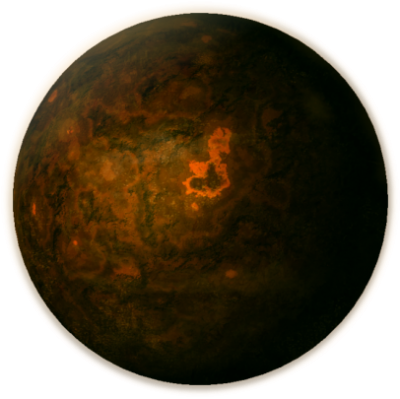
|
| DIAMETER | 1,000 - 10,000 km | |
| LOCATION | Hot Zone | |
| SURFACE | Partially molten | |
| ATMOSPHERE | Exremely Tenuous | |
| EVOLUTION | N/A | |
| LIFE FORMS | None | |
| EXAMPLES | Mercury, Nebhilum |
Class C - Geoinactive
When all volcanic activity on a Class A planet ceases, it is considered Class C. Essentially dead, these small worlds have cold, barren surfaces and possess no geological activity.
| AGE | 2-10 billion years | 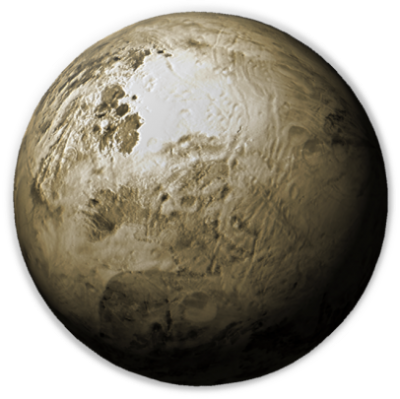
|
| DIAMETER | 1,000 - 10,000 km | |
| LOCATION | Hot Zone/Ecosphere/Cold Zone | |
| SURFACE | Barren | |
| ATMOSPHERE | None | |
| EVOLUTION | N/A | |
| LIFE FORMS | None | |
| EXAMPLES | Psi 2000 |
Class D - Dwarf
Also known as Plutonian objects, these tiny worlds are composed primarily of ice and are generally not considered true planets. Many moons and asteroids are considered Class D, as are the larger objects in a star system's Kuiper Belt. Most are not suitable for humanoid life, though many can be colonized via pressure domes.
Class E - Geoplastic
Class E planets represent the earliest stage in the evolution of a habitable planet. The core and crust is completely molten, making the planets susceptible to solar winds and radiation and subject to extremely high surface temperatures. The atmosphere is very thin, composed of hydrogen and helium. As the surface cools, the core and crust begin to harden, and the planet evolves into a Class F world.
Class F - Geometallic
A Class E planet makes the transition to Class F once the crust and core have begun to harden. Volcanic activity is also commonplace on Class F worlds; the steam expelled from volcanic eruptions eventually condenses into water, giving rise to shallow seas in which simple bacteria thrive. When the planet's core is sufficiently cool, the volcanic activity ceases and the planet is considered Class G.
Class G - Geocrystalline
After the core of a Class F planet is sufficiently cool, volcanic activity lessens and the planet is considered Class G. Oxygen and nitrogen are present in some abundance in the atmosphere, giving rise to increasingly complex organisms such as primitive vegetation like algae, and animals similar to sponges and jellyfish. As the surface cools, a Class G planet can evolve into a Class H, K, L, M, N, O, or P class world.
Class H - Desert
A planet is considered Class H if less than 20% of its surface is water. Though many Class H worlds are covered in sand, it is not required to be considered a desert; it must, however, receive little in the way of precipitation. Drought-resistant plants and animals are common on Class H worlds, and many are inhabited by humanoid populations. Most Class H worlds are hot and arid, but conditions can vary greatly.
| AGE | 4-10 billion years | 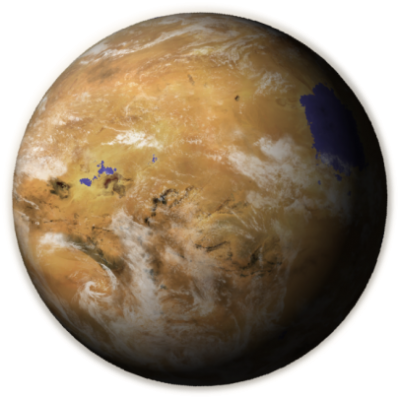
|
| DIAMETER | 8,000 - 15,000 km | |
| LOCATION | Ecosphere | |
| SURFACE | Hot, arid; >20% surface water | |
| ATMOSPHERE | Oxygen, nitrogen, argon, metals | |
| EVOLUTION | n/a | |
| LIFE FORMS | Drought-resistant plants/animals | |
| EXAMPLES | Nimbus III, Ocampa |
Class I - Ice Giant (Uranian)
Also known as Uranian planets, these gaseous giants have vastly different compositions from other giant worlds; the core is mostly rock and ice surrounded by a tenuous layers of methane, water, and ammonia. Additionally, the magnetic field is sharply inclined to the axis of rotation. Class I planets typically form on the fringe of a star system.
| AGE | 2-10 billion years | 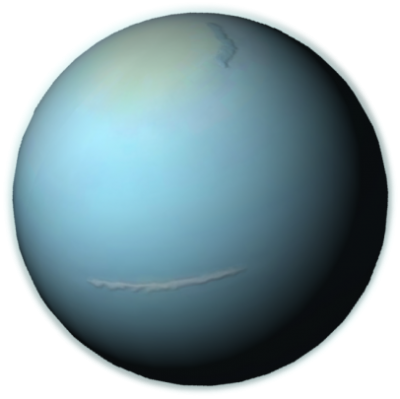
|
| DIAMETER | 30,000 - 100,000 km | |
| LOCATION | Cold Zone | |
| SURFACE | Rock, ice, methane, ammonia | |
| ATMOSPHERE | Hydrogen, Helium | |
| EVOLUTION | n/a | |
| LIFE FORMS | None | |
| EXAMPLES | Uranus, Neptune, Q'tahL |
Class J - Gas Giant (Jovian)
Class J planets are massive spheres of liquid and gaseous hydrogen, with small cores of metallic hydrogen. Their atmospheres are extremely turbulent, with wind speeds in the most severe storms reaching 600 kph. Many Class J planets also possess impressive ring systems, composed primarily of rock, dust, and ice. They form in the Cold Zone of a star system, though typically much closer than Class I planets.
| AGE | 2-10 billion years | 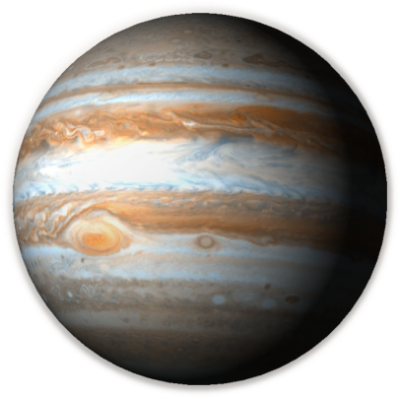
|
| DIAMETER | 50,000 - 500,000 km | |
| LOCATION | Cold Zone | |
| SURFACE | Liquid metallic Hydrogen | |
| ATMOSPHERE | Hydrogen, Helium | |
| EVOLUTION | n/a | |
| LIFE FORMS | None | |
| EXAMPLES | Jupiter, Saturn |
Class K - Adaptable
Though similar in appearance to Class H worlds, Class K planets lack the robust atmosphere of their desert counterparts. Though rare, primitive single-celled organisms have been known to exist, though more complex life never evolves. Humanoid colonization is, however, possible through the use of pressure domes and in some cases, terraforming.
Class L - Marginal
Class L planets are typically rocky, forested worlds devoid of animal life. They are, however, well-suited for humanoid colonization and are prime candidates for terraforming. Water is typically scarce, and if less than 20% of the surface is covered in water, the planet is considered Class H.
Class M - Terrestrial
Class M planets are robust and varied worlds composed primarily of silicate rocks, and are highly suited for humanoid life. To be considered Class M, between 20% and 80% of the surface must be covered in water; it must have a breathable oxygen-nitrogen atmosphere and temperate climate.
| AGE | 4-10 billion years | 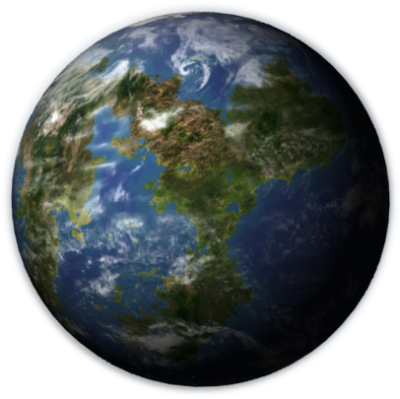
|
| DIAMETER | 10,000 - 15,000 km | |
| LOCATION | Ecosphere | |
| SURFACE | Abundant surface water, temperate climate | |
| ATMOSPHERE | Nitrogen, oxygen, argon | |
| EVOLUTION | n/a | |
| LIFE FORMS | Vegetation, animal, & humanoid | |
| EXAMPLES | Earth, Cardassia, Bajor, Vulcan |
Class N - Reducing
Though frequently found in the Ecosphere, Class N planets are not conducive to life. The terrain is barren, with surface temperatures in excess of 500° and an atmospheric pressure more than 90 times that of a Class-M world. Additionally, the atmosphere is very dense and composed of carbon dioxide; water exists only in the form of thick,vaporous clouds that shroud most of the planet.
| AGE | 3-10 billion years | 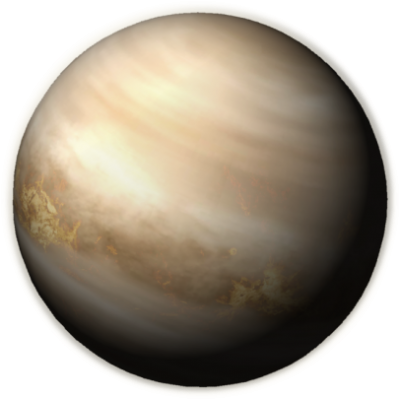
|
| DIAMETER | 10,000 - 15,000 km | |
| LOCATION | Ecosphere | |
| SURFACE | Barren, high temps. | |
| ATMOSPHERE | carbon dioxide and sulfides | |
| EVOLUTION | n/a | |
| LIFE FORMS | None | |
| EXAMPLES | Venus |
Class O - Pelagic
Any planet with more than 80% of the surface covered in water is considered Class O. These worlds are usually very warm and possess vast cetacean populations in addition to tropical vegetation and animal life. Though rare, humanoid populations have also formed on Class O planets.
Class P - Glaciated
Any planet whose surface is more than 80% frozen is considered Class P. These glaciated worlds are typically very cold, with temperatures rarely exceeding the freezing point. Though not prime conditions for life, hearty plants and animals are not uncommon, and some species, such as the Aenar and the Andorians, have evolved on Class P worlds.
Class Q - Variable
These rare planetoids typically develop with a highly eccentric orbit, or near stars with a variable output. As such, conditions on the planet's surface are widely varied. Deserts and rain forests exist within a few kilometers of each other, while glaciers can simultaneously lie very near the equator. Given the constant instability, is virtually impossible for life to exist on Class-Q worlds
Class R - Rogue
A Class R planet usually forms within a star system, but at some point in its evolution, the planet is expelled, likely the result of a catastrophic asteroid impact. The shift radically changes the planet's evolution; many planets merely die, but geologically active planets can sustain a habitable surface via volcanic outgassing and geothermal venting.
Class S - Gas Supergiant
Aside from their immense size, Class S planets are very similar to their Class J counterparts, with liquid metallic hydrogen cores surrounded by a hydrogen and helium atmosphere.
| AGE | 2-10 billion years | 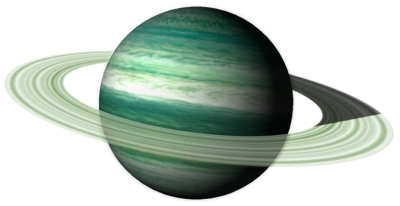
|
| DIAMETER | 500,000 - 100,000,000 km | |
| LOCATION | Cold Zone | |
| SURFACE | Liquid metallic hydrogen | |
| ATMOSPHERE | Hydrogen and helium | |
| EVOLUTION | n/a | |
| LIFE FORMS | None | |
| EXAMPLES | Tethe-Alla IV |
Class U - Gas Ultragiant
Class U planets represent the upper limits of planetary masses. Most exist within a star system's Cold Zone and are very similar to Class S and J planets. If they are sufficiently massive (13 times more massive than Jupiter), deuterium ignites nuclear fusion within the core, and the planet becomes a red dwarf star, creating a binary star system.
Class X - Chthonian
Class X planets are the result of a failed Class T planet in a star system's Hot Zone. Instead of becoming a gas giant or red dwarf star, a Class X planet was stripped of its hydrogen/helium atmosphere. The result is a small, barren world similar to a Class B planet, but with no atmosphere and an extremely dense, metal-rich core.
| AGE | 2-10 billion years | 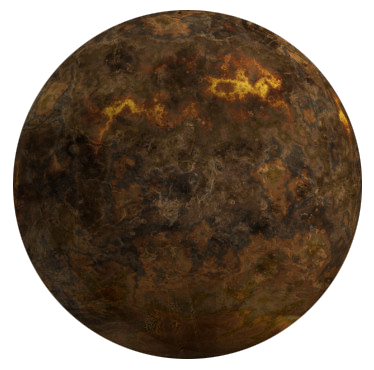
|
| DIAMETER | 1,000 - 10,000 km | |
| LOCATION | Hot Zone | |
| SURFACE | Barren, extremely hot | |
| ATMOSPHERE | None | |
| EVOLUTION | n/a | |
| LIFE FORMS | None | |
| EXAMPLES | Osirus |
Class Y - Demon
Perhaps the most environmentally unfriendly planets in the galaxy, Class Y planets are toxic to life in every way imaginable. The atmosphere is saturated with toxic radiation, temperatures are extreme, and atmospheric storms are amongst the most severe in the galaxy, with winds in excess of 500 kph.
| AGE | 2-10 billion years | 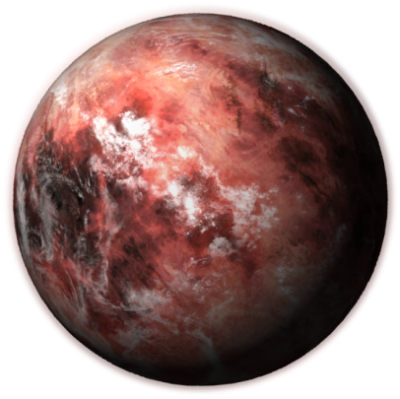
|
| DIAMETER | 10,000 - 15,000 km | |
| LOCATION | Hot Zone | |
| SURFACE | Barren, extremely hot | |
| ATMOSPHERE | Turbulent, with toxic radiation | |
| EVOLUTION | n/a | |
| LIFE FORMS | Mimetic | |
| EXAMPLES | Planet Hell (Delta Quadrant), Visalayan (Medusan) |
Disclaimer Notice
Page used with permission of USS Wolff CO - granted Nov 1, 2016
Images by Chris Adamek and used with permission from http://sttff.net/
